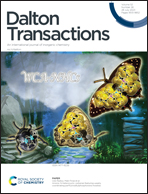Optical temperature-sensing phosphors with high sensitivities in a wide temperature range based on different strategies†
Abstract
Rare earth ion doped luminescent materials are considered potential candidates with a wide range of applications because of their unique optical characteristics. In this work, single-phase Yb3+–Er3+ and Yb3+–Tm3+ co-doped La1.55SiO4.33 (LS) phosphors of a hexagonal system for optical thermometers are reported. Three characteristic emissions of Er3+ were observed at 521, 553 and 659 nm in the LS:Yb3+,Er3+ phosphors under 980 nm excitation, which are assigned to the 2H11/2 → 4I15/2, 4S3/2 → 4I15/2 and 4F9/2 → 4I15/2 transitions, respectively. In the LS:Yb3+,Tm3+ phosphors, one can find two strong emissions at 474 and 790 nm and two weak emissions at 648 and 685 nm. Their upconversion (UC) luminescence mechanisms were studied from their pump-power-dependent spectra. When the samples were measured at various temperatures, their spectral features revealed that different fluorescence intensity ratio (FIR) strategies can be used to characterize their optical temperature-sensing behaviors. The sensor sensitivities were determined from the temperature-dependent UC emission spectra using thermally coupled energy levels (TCELs) and non-TCELs, which had improved compared with those of some other reported optical temperature-sensing luminescent materials. The device fabrication indicated that the developed UC phosphors are promising for applications in optical thermometers.



 Please wait while we load your content...
Please wait while we load your content...